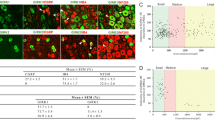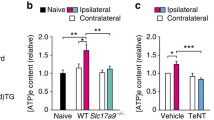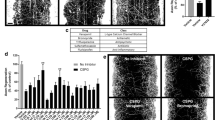Abstract
Vinca alkaloids were used to study the role of retrograde axon transport (RT) in activating neuron perikaryal repair response to nerve transection. Mouse lumbar dorsal root ganglia (DRG) (L4-L6) were excised 48 hours after unilateral transection of the sciatic nerve and ornithine decarboxylase (ODC) activity determined. ODC activity in DRG ipsilateral to nerve transection was increased 10–20 fold over contralateral values. Typical ODC activities in ipsilateral and contralateral DRG samples were 6.18±1.4 and 0.31±0.09 pmol14CO2 released/h/3DRG, respectively. Systemic administration of single doses of either vincristine (1 mg/kg) or vinblastine (5 mg/kg) immediately prior to axotomy attenuated ODC induction in ipsilateral DRG by 39% and 47%, respectively. A direct inhibition of ODC activity in the DRG appears unlikely since only high concentrations of vinblastine (0.5–1.0 mM) were able to inhibit ODC activity in vitro. We suggest vinca alkaloids inhibit ODC induction as a consequence of distupting retrograde axonal transport. Interruption of this intracellular communication mechanism may be etiologically linked to the distal axon degeneration which follows repetitive exposure to vinca alkaloids and other agents that induce toxic axonal neuropathy.
Similar content being viewed by others
References
Nissl, F. 1892. Uber die veranderungen der ganglienzellen um facialiskern des kannuncheng nach ansreissung der nerve. Allq. Z. Psychiatrie 48:197–206.
Gilad, G. M., and Gilad, V. H. 1983. Early rapid and transient increase in ornithine decarboxylase activity within sympathetic neurons after axonal injury. Exper. Neurology 81:158–166.
Dornay, M., Gilad, V., Shiler, I., and Gilad, G. M. 1986. Early polyamine treatment accelerates regeneration of rat sympathetic neurons. Exper. Neurology 92:665–674.
Russell, D. H. and Snyder, S. H. 1968. Amine synthesis in rapidly growing tissues: ornithine decarboxylase activity in regenerating rat liver, chick embryo and various tumors. Proc. Natl. Acad. Sci. U.S.A. 60:1420–1427.
Singer, P. A., Mehler, S., and Fernandez, H. L. 1982. Blockade of retrograde axonal transport delays the onset of metabolic and morphologic changes induced by axotomy. J. Neurosci. 2:1299–1306.
Kanje, M., Fransson, I., Edstrom, A., and Lowkvist, B. 1986. Ornithine decarboxylase activity in dorsal root ganglia of regenerating frog sciatic nerve. Brain Res. 381:24–28.
Casey, E. B., Jellife, A. M., Le Quesne, P. M., and Millett, Y. L. 1963. Vincristine neuropathy. Brain 96:69–86.
Himes, R. H., Kersey, R. N., Heller-Bettinger, I., and Samson, F. E. 1976. Action of the vinca alkaloids vincristine, vinblastine, and desacetyl vinblastine amide on microtubules in vitro.Cancer Res. 36:3798–3802.
Bunt, A. H. and Lund, R. D. 1974. Vinblastine-induced blockage of orthograde and retrograde axonal transport of protein in retinal ganglion cells. Exp. Neurol. 45:288–297.
Chan, S. Y., Worth, R., and Ochs, S. 1980. Block of axoplasmic transport in vitro by vinca alkaloids. J. Neurobiol. 11:251–264.
Edstrom, A., Ekstrom, P., Kanje, M. and Sojberg, J. 1987. The use of the regenerating frog sciatic nerve for pharmacological studies of orthograde and retrograde axonal transport. Brain Res. 401:34–42.
Soiefer, A. I., Moretto, A., Sabri, M. I., and Spencer, P. S. 1987. Vinca alkaloids inhibit the neuron perikaryal response to axotomy. Toxicologist 7:53.
Russel, D. H. and Snyder, S. H. 1968. Amine synthesis in rapidly growing tissues: Ornithine decarboxylase in rat liver. Endocrinology 86:1414–1419.
Bradford, M. 1976. A rapid and sensitive method for the quantitation of microgram quantities of protein utilizing the principle of protein-dye binding. Anal. Biochem. 72:248–254.
Spencer, P. S., Miller, M. S., Ross, S. M., Schwab, B. and Sabri, M. I. 1985. Biochemical mechanisms underlying primary axonal degeneration. Pages 31–65,in Lajtha, A. (ed.), Handbook of Neurochemistry, Vol. 9, Plenum Press, New York.
Sabri, M. I., Soiefer, A. I., Moretto, A., Lotti, M., Miller, M. S., and Spencer, P. S. 1987. Early retrograde transport defects induced by primary axonal toxins. Pages 459–472,in Smith, R. C. and Bisby, M. A. (eds.), Axonal Transport, Alan R. Liss, Inc. New York.
Moretto, A., Lotti, M., Sabri, M. I., and Spencer, P. S. 1987. Progressive deficits of retrograde axonal transport is associated with the pathogenesis of di-n-butyl dichlorovos axonopathy. J. Neurochem. 49:1515–1522.
Kristensson, K. and Olsson, Y. 1975. Retrograde transport of horseradish peroxidase in transected axons. II. Relations between rate of transfer from the site of injury to the perikaryon and onset of chromatolysis. J. Neurocytol. 4:653–661.
Bisby, M. A. 1984. Retrograde axonal transport and nerve regeneration. Pages 45–67,in Elam, J. S. and Cancalon, P. (eds.), Axonal Transport in Neuronal Growth and Regeneration. Plenum Press, New York.
Miller, M. S., and Spencer, P. S. 1984. Single doses of acrylamide reduce retrograde transport velocity. J. Neurochem. 43:1401–1408.
Moretto, A. and Sabri, M. I. 1988. Progressive deficits in retrograde axon transport precede degeneration of motor axons in acrylamide neuropathy. Brain Res. 44:18–24.
Author information
Authors and Affiliations
Rights and permissions
About this article
Cite this article
Soiefer, A.I., Moretto, A., Spencer, P.S. et al. Axotomy-induced ornithine decarboxylase activity in the mouse dorsal root ganglion is inhibited by the vinca alkaloids. Neurochem Res 13, 1169–1173 (1988). https://doi.org/10.1007/BF00971635
Accepted:
Issue Date:
DOI: https://doi.org/10.1007/BF00971635




